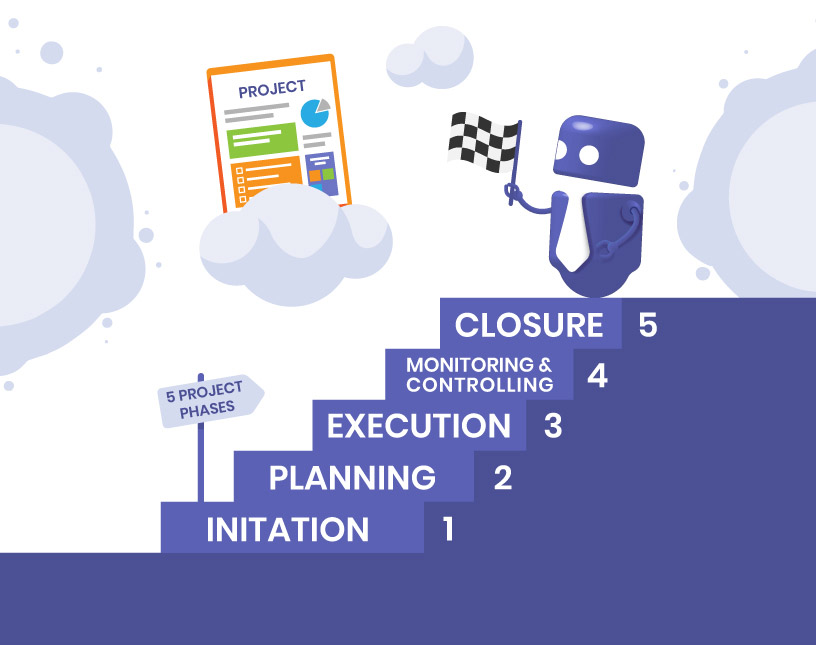The 5 Phases of Project Management
Why Are the Phases of Project Management Important?
One best practice for project management is to divide the project into different project management phases. This offers several benefits:
It allows for improved planning and management by breaking the project down into manageable parts, each with its own specific objectives, deliverables, and deadlines. Phases facilitate sequential completion of tasks, ensuring that a project follows a logical progression from inception to closure. Risk and change management is also improved, as potential issues can be identified and addressed within each phase before moving to the next. Phased project management makes it easier to monitor and control project performance, as each phase offers a natural checkpoint for evaluation and review.
The number of different phases in a project management model can indeed vary, with common models outlining 4, 5, or even 7 steps. The phases you follow will largely depend on the specific needs of your project or the standard practices within your industry or organization.
With Microsoft Teams, project management and especially managing all five phases of the project management process is easy. The integrated, collaborative nature of Microsoft Teams can substantially streamline and optimize your work as a project manager.
Project Management With Four Phases
The four-phase model, also known as the Directing a Project (DP) model, primarily comes from PRINCE2 (Projects In Controlled Environments), a popular project management methodology. The phases are:
- Start Up – Defining the project, preparing a business case, and planning for the next stage.
- Initiation – Detailed planning, risk analysis, and setting up project controls.
- Delivery – Managing and controlling project work, stages, and any changes.
- Closure – Finalizing all activities, handing over deliverables, and post-project review.
These four phases of project management could be used, for example, for implementing a new software product.
What are the Phases of Project Management?
This model is known as the Project Management Institute’s (PMI) Project Management Body of Knowledge (PMBOK) Guide’s five-phase Project Management process, and is the most widely used model. The phases are:
- Initiating – Defining the project at a broad level.
- Planning – Outlining the specific tasks, timelines, and resources required.
- Executing – Doing the work outlined in the project plan.
- Monitoring and Controlling – Tracking the progress of the project to make sure it stays on schedule and within budget.
- Closing – Finalizing all project activities and formally closing the project.
The five phase model is frequently used for construction projects, among others.
How does the Seven-Phase Model for Project Management look like?
This model, often used in larger or more complex projects, provides more granularity in the stages of the project. The phases are:
- Concept – Idea generation and feasibility study.
- Definition – Outlining the project scope, objectives, and structure.
- Planning and Design – Detailed planning of project activities, resources, timelines, and risk assessment.
- Development – Building the product or service, including quality assurance processes.
- Implementation – Delivering the product or service.
- Follow-up – Ongoing support, troubleshooting, and performance measurement.
- Closure – Finalizing the project, releasing resources, and conducting a project review.
This model is suited for large-scale, very complex projects, such as for example the implementation of a national investment program.
Why should you focus on project phases?
Focusing on project phases is essential in project management as it provides structure and order to the project, ensuring that it progresses in a logical and systematic manner.
By breaking down the project into distinct phases, project team members can have clear visibility of their responsibilities, deadlines, and deliverables at each stage. Understanding and implementing project management phases effectively can lead to improved communication, coordination, and ultimately, the successful completion of the project.
Let’s take a closer look at the individual phases of a project!
Phase 1: Project Initiation
Project initiation is the first phase in the project management lifecycle and a key part of any project management methodology. It is during the project initiation phase that the need for the project is identified and a decision is made to move forward with the project.
The main deliverable of this phase is the project charter. The project manager, along with other key project stakeholders, needs to define the project’s purpose, objectives, scope, stakeholders, constraints, and high-level risks. The charter serves as the cornerstone for the entire project, providing a shared understanding for everyone involved in the project.
This initiation phase sets the stage for all subsequent project tasks and lays the foundation for the project work ahead. It’s crucial to ensure that the document is thorough and accurate because errors or oversights during this phase can cause problems later in the project lifecycle. The charter is not a detailed management plan, but rather a high-level document that provides a roadmap for the project.
After the charter is approved, the project manager can move on to more detailed planning, including developing a project schedule, identifying specific tasks, and devising a comprehensive risk management plan. This often involves using project management software to help organize and track the project’s progress.
The initiation phase is not just about creating documents; it’s also about establishing relationships and clear communication channels with stakeholders. Ensuring that all key players are engaged and have a shared understanding of the project at this early stage is vital to the success of every project.
Microsoft Teams is a good tool for conducting initial discussions about a project. Create a dedicated channel for your project where you can post the project proposal, discuss with stakeholders, and finalize the project charter. You can use the video meeting feature for kickoff meetings and discussions further on.
By using a request process and approval workflow in MS Teams, organizations can ensure the creation of new project teams is streamlined and controlled, mitigating the risk of unnecessary or duplicate teams. With naming conventions for teams, you can maintain a consistent and professional appearance across all teams, which can be particularly beneficial for large organizations with many teams.
What is stakeholder analysis and why is it important?
Stakeholder analysis, which is also a part of the Initating phase of a project, is a process where you identify all individuals, groups, or entities who have an interest in or could be affected by the project, and evaluate their influence, expectations, and potential impact on the project. This analysis is key to determine the scope of the project, as stakeholders’ needs and expectations often directly influence what the project should achieve.
By understanding stakeholders’ interests, the project leader can develop strategies to engage them effectively, manage their expectations, and address their concerns – all of which are vital to keep the project on track. Moreover, stakeholder analysis can help determine whether the project is likely to receive the necessary support and resources, contributing to a successful project outcome.
Phase 2: Project Planning
The Planning phase in project management involves defining detailed objectives, deliverables, and activities needed to achieve the project’s goals. It’s during this stage that the project team develops a comprehensive project plan, including a timeline, budget, resource allocation, risk management plan, and communication strategy. The planning phase lays out the roadmap for the entire project, setting clear expectations for what needs to be done, by whom, and when. It’s also the launch of the task management topics that will continue throughout the whole project.
With Microsoft Teams, you can create separate channels or tabs for different planning aspects like schedule, budget, resources, and risk management. Microsoft Planner can be used for task management in Microsoft Teams to create detailed task lists, assign tasks to team members, and set deadlines. You can also use shared spreadsheets in Teams for budget planning, for example.
Project room templates are useful in this phase. Templates allow organizations to use any team as a blueprint, adding channels, tabs, folders, files, or apps, such as Planner and OneNote, with just a few clicks. Templates can also have pre-configured user permissions and settings, providing a clear and structured framework for internal and external team members from the get-go.
What is the difference between Project Initiation and Project Planning?
In the Initiating phase, you’d outline the project’s purpose, benefits, rough budget, preliminary timeline, and key stakeholders. The project charter is created, which documents this information and formally authorizes the project.
Once the project charter is approved, you move to the Planning phase. Here, you dive into the details. You would identify specific tasks, estimate timeframes, allocate resources, and create a project schedule. You would also plan for potential risks (like delays or technical issues) and how to communicate with stakeholders.
For example, in the project Initiation phase, you would identify the need for a new website (e.g., to increase online presence, improve customer engagement, sell products online). In the Planning phase, you’d outline the website’s structure, design, and content and list the required tasks (e.g., purchase a domain, hire a web designer, create content).
So basically, the Initiating phase is about defining “why” and “what” at a high level, while the Planning phase is about defining “how”, “who”, “when”, and “what if”.
Phase 3: Project Execution
During the project execution phase, the project manager leads the team to complete the tasks according to the project plan. This phase involves managing team members, resources, costs, and stakeholders, maintaining effective communication, ensuring work quality, and addressing any issues or changes.
Coordinating the execution of tasks with a tool is basically a must, and Microsoft Teams is one great option. Through Microsoft Planner, tasks can be tracked, and team members can update their progress. Regular meetings can be held using MS Teams to update the team on the project’s status and to resolve any issues.
Project managers should be aware of several common mistakes during the project execution phase, for example:
Poor Communication
Effective communication is key in project execution. Failing to keep everyone informed about project status, changes, or issues can lead to confusion and mistakes.
Lack of Flexibility
Even with a solid project plan, changes are inevitable. The project manager needs to be able to adapt to changes and update the plan as needed.
Ignoring Small Issues
Minor problems can quickly escalate if not addressed promptly. Regularly monitoring project progress and addressing issues as they arise is crucial to keep the project on track.
Poor Risk Management
Not all risks can be identified upfront during the planning phase. Continuous risk assessment and management during the execution phase are vital.
Resource Mismanagement
Whether it’s people, time, or materials, mismanagement of resources can lead to delays, increased costs, and quality issues.
Phase 4: Project Monitoring and Controlling
The project monitoring and controlling phase of project management is a continuous process that occurs alongside project execution. This phase involves tracking, reviewing, and regulating the progress and performance of the project to meet the objectives defined in the project plan.
In this phase, the project manager plays a pivotal role by ensuring that the project stays on track in terms of time, cost, quality, and scope. Key activities include measuring project performance using appropriate tools and techniques, comparing actual progress with planned progress, identifying any variances, and taking corrective actions when necessary.
This phase is also where any changes to the project plan are managed. The project lead should have experience in assessing change requests – evaluating their impacts, deciding whether to approve them, and if approved, updating the project plan and communicating the changes to all stakeholders.
Another crucial part of this phase is quality control, which involves checking that each deliverable is up to the required standard. If a deliverable doesn’t meet the required quality, the project manager needs to identify the root cause and implement corrective actions.
With Microsoft Planner or Microsoft Project, project managers can easily monitor the project’s progress, checking off completed tasks and monitoring overdue ones. Teams can also be used to manage change requests and to communicate changes to all stakeholders.
Phase 5: Project Closure
Phase 5, often called project closing or project closure, is the final phase of the project management process. It signifies the completion of the project. The aim is to wrap up all project activities, ensure all deliverables are handed over and accepted, and formally close the project.
As a project manager, your responsibilities during project closing include confirming that all project objectives have been met, and that all deliverables are completed and accepted by the stakeholders. You also need to ensure that all project documentation is finalized and stored for future reference.
The end of the project is also a time to conduct a project review or “post-mortem” analysis, where the entire project is evaluated in order to identify successes, challenges, and lessons learned to improve future projects.
Other essential tasks include formally releasing project resources, including team members, and providing any necessary feedback or performance assessments.
The project closing phase, although often overlooked, is an essential phase of the project management process. It ensures a clear end to the project and provides valuable insights for future projects. The completion of this phase signifies the successful delivery of the entire project.
A final Closure meeting can be conducted via Microsoft Teams to discuss all of the above. All project documentation can be uploaded to the project channel for future reference. Over time, it also makes sense to archive completed projects and inactive Teams project rooms.
At the project closure stage, an automated lifecycle feature can be beneficial. As projects come to an end, you can archive and eventually delete the corresponding project teams, helping to maintain a clean and efficient workspace. Additionally, organizations should make sure to manage the access rights of external users as the project concludes, ensuring secure and compliant project closure.

What are the 5Cs in project management?
The so-called 5Cs are a useful framework for managing projects. They describe five key aspects of project management and are close to, but not quite identical, to the five project phases.
Clarify
Defining and understanding the objectives, scope, and stakeholders of the project. Describing the project’s goals in a SMART way (specific, measurable, achievable, relevant, and time-bound). Clarification also means understanding the stakeholders and their expectations.
Care (to Plan)
Careful planning includes the project schedule, budget, risk management plan, and communication strategy, among other things.
Control
Monitoring the project’s progress to ensure it stays on track. Bringing the project back on course in case of deviations. Also, managing changes and risks that arise during the execution of the project.
Communicate
Keeping all stakeholders informed about the project’s progress, any changes, and any issues. Ensuring that the project team has the information and support they need to carry out their tasks.
Close
Finalizing the project after all tasks are completed and deliverables handed over. Reviewing the project to identify lessons learned and applying those lessons to future projects.
Project Management Phases in Microsoft Teams
As our own focus lies in Microsoft Teams, we are of course also curious how well Microsoft Teams covers the different project management phases. In our view, managing projects in Teams makes a lot of sense as it offers many tools and controls for each of the phases.
For one, during the ‘Initiating’ and ‘Planning’ stages, Microsoft Teams project management tools facilitate clear communication and detailed task organization.
In the ‘Executing,’ ‘Monitoring and Controlling,’ and ‘Closing’ phases, teams collaboration within Microsoft Teams ensures that project milestones are met efficiently.
FAQ about Project Management Phases
The five main elements of effective project management, often referred to as the five P’s, are:
• Purpose: Clearly define the project’s goals, objectives, and expected outcomes.
• Planning: Develop a comprehensive plan that includes schedule, budget, resource allocation, risk management, and communication strategies.
• People: Build and manage a competent project team and maintain effective communication with all stakeholders.
• Performance: Monitor and control the project’s progress, ensuring it aligns with the plan. Make necessary adjustments in response to changes and issues.
• Post-completion Review: Conduct a thorough review of the project after completion to identify successes, challenges, and lessons learned for future projects.
The Project Management Life Cycle is a framework for managing projects, proposed by the Project Management Institute (PMI), comprising of five phases that every project goes through from start to finish. It’s a systematic approach to guide the project from inception to completion. While other models with 4 or 7 steps exist as well, the 5-step model is most often used.
Initiation: This phase marks the beginning of the project. Here, the need for the project is identified and a high-level plan is developed. The key deliverable is the project charter, which includes the project’s purpose, stakeholders, objectives, and preliminary scope.
Planning: This phase involves creating a detailed project plan which outlines the what, who, how, and when of the project tasks. This includes schedules, budgets, resources, risks, and communication plans. Project management software or tools may be used to facilitate the planning process.
Execution: In this phase, the project plan is put into action to create the project’s deliverables. The project team performs the tasks defined in the project plan under the direction of the project manager.
Monitoring and Control: This phase runs concurrently with execution and involves tracking, reviewing, and regulating the progress and performance of the project. This ensures the project stays on track and that quality deliverables are produced.
Closure: This final phase happens after the completion and delivery of the project deliverables. It involves finalizing all project activities, conducting a post-project review, and formally closing the project.
A project charter is a formal document that outlines the purpose, scope, and stakeholders of a project. It is typically created during the initiation phase of a project and often considered the foundational document of a project, serving as a reference point for all project-related decisions.
Typical components of a project charter include:
• Project Purpose or Justification
• Project Description
• Project Scope
• Project Objectives
• Project Constraints and Assumptions
• Project Risks
• Stakeholder List
• Project Authority
• Project Resources
• Project Timeline
• Project Approval
Every project goes through various stages, from initiation to closure. Understanding and effectively managing these phases directly impacts the project’s performance. When a project is defined and planned well during the initiation and planning stages, it sets a strong foundation for the project’s execution. It helps in proper allocation and control of resources, including the project budget, which is critical to the success of the project.
Mismanagement or overlooking any of these phases can lead to scope creep, cost overruns, delays, or even project failure. Therefore, a clear understanding of each project phase is essential for successful project management.
Project management software is often a key asset in managing a project through the five phases of project management. During the initiation phase, software can aid in determining whether the project is feasible and if the outcome of the project will solve the problems it’s intended to. It facilitates collaboration and communication, making it easier to get the project approved. During the planning phase, the software aids in creating a detailed project plan, defining tasks, resources, and timelines.
In the execution phase, project management tools help to track progress and manage resources effectively. During the monitoring and control phase, they assist in implementing an effective change management plan, accommodating changes in the project as needed. In the final closure phase, project management software helps to organize and store project materials in a shared space for future reference. Thus, project management software can significantly enhance the efficiency and success of every project across all life cycle phases.
Project management is often distilled down to the basics known as the project life cycle, divided into distinct phases, each with its unique aspects. This understanding of project management life cycle phases helps to structure the journey from the project’s inception to its successful completion. The life cycle typically comprises five phases of project management.
It starts with initiation, where the project’s feasibility is assessed, and the project is approved. The planning phase is where the project’s journey is charted out, with resources, schedules, and plans defined by the project objectives. Execution is where the project comes to life, with tasks being carried out as per the plan. Monitoring and controlling is an ongoing phase, tracking project progress, and ensuring changes are effectively managed. The final phase, closure, marks the project’s successful completion, with a formal review and archiving of project materials. Thus, understanding the stages of project management and the role each phase plays is fundamental to successful project management.

Teams Manager For All Project Management Phases in Microsoft Teams
With Teams Manager, you can optimize all five project management phases by offering streamlined team creation, customizable templates for standardized project rooms, detailed metadata, automated lifecycle management, and secure guest access.
Whether initiating a new project, planning its framework, executing tasks, monitoring progress, or concluding a project, Teams Manager ensures efficiency, control, and compliance. Don’t miss out on the opportunity to enhance your project management processes – book a demo today to explore the full capabilities of Teams Manager!

CEO and Governance Expert – Christian Groß is a Teams expert from the very beginning. In the last 4 years he developed 6 Teams Apps, built up his own service company and additionally founded the largest German-speaking Teams conference.







